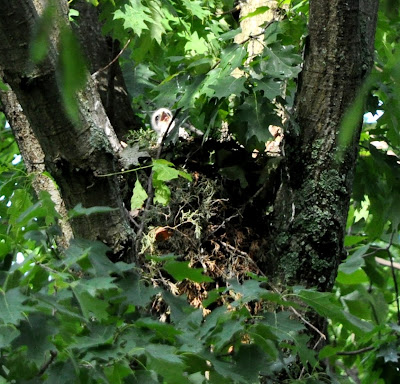Over the next few days I am going to share a few of my opening blog posts that show last years Red-Shouldered Hawks brooding season. Many of these first posts only had one image to them. It took me a couple of months before another kind blogger shared with me that I could be placing more than one image per post...it was a great learning process.
Breeding season for the 2009 year began on Tingsgrove March 16. A few nest sites were being refurbished, and then the last hour, for whatever reasons...the hawks decided on an old nest site that had never worked before. They had no time to refurbish it, prior to the egg laying process. This site was used before a couple of times, but the young were always taken by Raccoons. The property owners allowed me to place pending on several of the trees that had branches that could lead to nest and this has proved in years past at other sites, to be a great solution in stopping the coons from having access to the nest. Brooding season began approximately on March 22. The female does nearly all of the brooding and a nice green canopy soon covered her nest site, but while the canopy was bare, it placed the hen and her unborn chicks in a more vulnerable position from the also active Red Tailed Hawks, as well as Great Horned Owls, though for most part,they try not to cross territories. The hen has a very long brooding time, and only leaves the nest a couple of times a day, and only for brief trips very close to nest. The male brings meals to the female during this time as well as to the nestlings once they are hatched. This particular female enjoyed little bathing trips to a nearby boat that held water next door to nest tree, but I was never able to capture these events, though two neighbors witnessed it, much to their delight. Some days the adult female was watching the nest so intently, I could slip very cautiously beneath her...keep in mind, I was using a 135 mm lens too. I was able to observe the chicks for the first time on May 19, though I had seen the hen feeding young a good week, or more prior to this date. The young eyas grew so rapidly, it was an amazing transition. The silken fluffy down was soon covered with new feathering. It was great being able to observe the happenings from the nest rim. Some nest sites are quite difficult to observe from, depending, on how high, and how many branches obscure it. I am also always at the mercy of the sunlight, as to whether my photographs turn out very well. So powerful, yet so gentle with her young Eyas, these are a very devoted and dedicated species. It takes a lot of care to successfully raise these young ones. The adult gently adult parcels out bits of food to her young eyas. Afterwards, at this stage she can also have a meal with what remains. The female was quite the doting "Mom", but the attachments do not last for long once they are about 17 to 19 weeks old, they are pretty much on their own, until they mate themselves. Sometimes juvies from the year past, will soar with adult parents and their cousins, and even share in large meals taken~
Cherish is my favorite word, and I cherish the ability of turning the routine into a beautiful moment.
Nature creates in me, a spiritual and meditative time to bring peace, harmony and balance, into an otherwise ordinary day~
Mary Howell Cromer
Saturday, January 23, 2010
The next few days I am going to share a few of my opening blog posts that show last years Red-Shouldered Hawks brooding season~
1 comment:
I enjoy each visitor to "Red Shouldered Hawks of Tingsgrove and Beyond" I truly appreciate those who have become followers to my blog and really am encouraged by the wonderful comments.
FYI if you leave ANONYMOUS comments, they will never get published, so please don't waste your time.
Thanking you~
Subscribe to:
Post Comments (Atom)








It's good to see that they put the metal bands around the trees to keep the racoons away. Hopefully that works. Seeing the little white chick with its tongue out is so precious! What an experience you had. Hopefully you'll have a repeat performance this year.
ReplyDelete